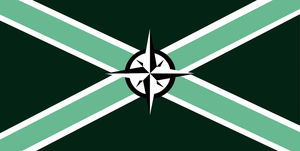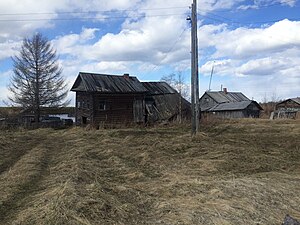Koskenkorva
| Koskenkorva | |
 Flag | |
| Country | Kiravian Federacy |
| Capital and largest city |
Valkadun |
| Population | 5.4 million |
| First Executive | Íoxanen S.D.L. Sölvakiur |
| Chancellor | Þylatur K.R.I. Xalivorn |
| Stanora seats | 3 |
| Official languages | Koskenkorvan Coscivian FennoKoskenkorvan |
| Postal Abbreviation | MRD |
Koskenkorva is an island state of the Kiravian Federacy located to the northeast of Great Kirav in the Sea of Valēkas.
History
The history of Coscivian civilisation in Ixnay begins on Koskenkorva. The Coscivian explorer Kedhur Valēkas first set foot on Ixnayan soil at Nimbus Point near modern-day Valkadun in 2XXXX. At the time, the island was inhabited primarily by Finnic-speaking peoples, with whom Valēkas' expedition made contact and exchanged diplomatic gifts. After circumnavigating the island, Valēkas turned south, eventually discovering Great Kirav and wintering in what is now Valēka. Valēkas called at Koskenkorva on his return journey and on each of his subsequent expeditions, eventually establishing a fort and trading post at Valkadun.
Cromwelute Wars
In the opening years of X decade, the Coscivian Empire joined forces with the Celtic chiefdoms of Great Kirav and the Finnic tribes of Koskenkorva against the Cromwelutes. At the outset of the war, the Cromwelutes controlled the northern third of the island and several settlements on the southeast coast, while Finns retained control of the interior and the Coscivian presence was largely confined to the southern third. Coscivian cavalry and border rangers from the northeastern colonies helped the Finns push outward and northward, eliminating Cromwelute settlements as they went, while the Coscivian Navy, technologically advanced for its time, interdicted reinforcements.
Following the war, the Finns of Koskenkorva joined the major Celtic chiefdoms and the Coscivian colonies in the Commonwealth of Arms, a defencive and diplomatic pact to prevent the polities from weakening each other through wars and unite against future Cromwelute incursions. The Coscivians repopulated the Cromwelute settlements that they had taken on Koskenkorva, mostly with Keregūlem, Scādem, and Āmskem colonists, and reīnforced their southern holdings.
Coscivian Province to Confederate Republic
In XXXXX, the Commonwealth of Arms was absorbed into the Coscivian Imperial system, with the three Finnic kings of Koskenkorva pledging fealty to the Coscivian Emperor. Koskenkorva was incorporated into the Empire as a unitary province and a Viceroyalty in its own right, and was not folded into the Dominion of Kiravia.
Nordic Reconquest
Liberation to Kirosocialism
Reunification
Society & Culture
Koskenkorva represents a unique cultural fusion of Coscivian and Finnic culture. In the centuries since the Cromwelute Wars, the Koskenkorvan Coscivians and Fenno-Koskenkorvans have come to generally consider themselves a single people differentiated into Coscivian-speaking and Finnic-speaking communities. Koskenkorvans account for over 90% of the state's population, with about 55% of the total being primarily Finnic-speaking and 35% of the total primarily speaking Koskenkorvan Coscivian. Due to linguistic and local administrative reforms in the 21190s, individuals can only report themselves as Fennophone, Coscophone, or Other/Deaf for administrative purposes such as school enrolment and internal passports. However, an estimated 6-10% of ethnic Koskenkorvans are natively bilingual, many of whom were raised in cross-linguistic households.
For federal statistical and affirmative action purposes, Coscivian-speaking Koskenkorvans are classified as Coscivians, whereas Finnic-speaking Koskenkorvans are placed in the National Minority category. The state government does not recognise this distinction.
The largest religious body in Koskenkorva is the Koskenkorvan People's Church, a high-church Lutheran denomination. It is adhered to by some 65% of the population. Other major Christian denominations include the Coscivian Orthodox, Roman Catholic, and Insular Apostolic churches.
Koskenkorvans are stereotyped as laconic, earthy, tough, solitary, and rather depressed, as shaped by their harsh environment, tumultuous history, and dismal weather.


Economy
Farming, fishing, lumbering and mining are the historical mainstays of the Koskenkorvan economy. Over one-third of Koskenkorvan households are directly involved in fishing or agriculture. Most agriculture is for subsistence purposes, growing staples such as cale, potatoes, chickens, hogs, and mushrooms.
Since reunification with Kiravia, tourism has grown into a major industry in Koskenkorva, with thousands of mainland Kiravians travelling to visit the state's pristine lakes, breathtaking seaside cliffs and fjords, Coscivian historical sites, and puffin colonies. This tourism trade has also given rise to cottage industries in handicrafts, local pastries, and mead.
Meridiælum SAK, headquartered in Kārtulin, is the second-largest Kiravian producer of bottled water, most of which is sourced from springs and aquifers in Koskenkorva.

Energy
10% of electrical energy in Koskenkorva is generated by the combustion of peat, which is abundant across most of the island. Peat is also the main fuel used for domestic heating. Peat extraction is conducted by most rural households in an artisanal fashion, either individually or (more commonly in the northern parts of the island) on a local coöperative basis. More sophisticated commercial peat-cutting operations also exist. Peat resources in Koskenkorva are regulated by a dedicated agency of the state government reporting to the Secretary of Peat.
Politics
Like all Kiravian states, Koskenkorva is a constitutional republic, and is regarded as the most direct-democratic state after New Harbour. Legislative responsibility is divided between the Hearing, an open legislative forum open to all adult, citizen males able to attend its biannual sessions at the vernal and autumnal equinoxes, and the General Court of Koskenkorva, a more conventional legislature elected every two years by alternative vote. Executive power belongs to the First Executive of Koskenkorva, who is appointed by the Prime Executive of the Kiravian Federacy on the advice of the General Court, until 21220 when the position will be filled by direct popular election.
There are four classes of municipal governments in Koskenkorva: Cities, towns, hundreds, and villages. Towns, hundreds, and villages operate as direct democracies.
| Party Name | General Court | Federal Caucus | Platform | |
|---|---|---|---|---|
| Koskenkorvan Civil Union Koskenkorvax Þóliþūra |
34 / 80 |
SRA | Conservative liberalism, Shaftonist democracy, Koskenkorvan subnationalism, Bilingualism | |
| New Community Party - Finnic People's Party Inox Skámiplaiduv - Svómix Plānoplaiduv |
21 / 80 |
non-inscrit | Centrism, Finnic-speakers' interests | |
| Independent Party Suluanþix Plaiduv |
10 / 80 |
KFA | Agrarianism, Localism, Fishermens' interests, Soft antifederalism | |
| Christian Political Party Xristūrisēx Ostraplaiduv |
6 / 80 |
CSU | Distributism, Christian democracy | |
| Independents |
9 / 80 |
-- | -- | |
| Social Democratic Party Soksàliþéruārkarisēx Plaiduv |
2 / 80 |
NDA | Social democracy |
Government Ministries: Secretariat of State Affairs - Responsible for external affairs, state protocol, civil registration, trade and tourism initiatives, commercial regulation, and electoral matters.
Secretariat of Defence - Responsible for the Koskenkorvan Armed Forces and militia.
Secretariat of Public Security - Responsible for state police, civil defence, and emergency management.
Secretariat of Peat - Responsible for managing peat resources and peat bog conservation.
Secretariat of Fisheries & Marine Resources - Pretty much what you'd expect